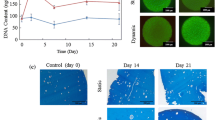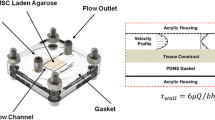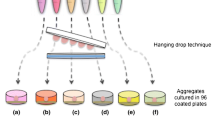Abstract
Without using biochemical agents, in this study, we sought to investigate the potential of controlling the differentiation of mesenchymal stem cells (MSCs) into a specific cell type through the use of 3D co-culturing and mechanical stimuli. MSCs and primary cultured chondrocytes were separately encapsulated into alginate beads, and the two types of beads were separated by a membrane. For the investigation a computer-controllable bioreactor was designed and used to engage intermittent hydrostatic pressure (IHP). Five different magnitudes (0.20, 0.10, 0.05, 0.02 MPa and no stimulation) of IHP were applied. The stimulation pattern was the same for all groups: 2 h/day for 7 days starting at 24 h after seeding; 2 and 15 min cycles of stimulating and resting, respectively. Biochemical (DNA and GAG contents), histological (Alcian blue), and RT-PCR (Col II, SOX9, AGC) analyses were performed on days 1, 5, 10, and 20. The results from these analyses showed that stimulation with higher magnitudes of IHP (≥0.10 MPa) were more effective on the proliferation and differentiation of co-cultured MSCs. Together, these data demonstrate the potential of using mechanical stimulation and co-culturing for the proliferation and differentiation of MSCs, even without biochemical agents.




Similar content being viewed by others
References
Wang D, Park JS, Chu JS, Krakowski A, Luo K, Chen DJ, Li S. Proteomic profiling of bone marrow mesenchymal stem cells upon transforming growth factor beta 1 stimulation. J Biol Chem. 2004;279:43725–34.
Johnstone B, Hering TM, Caplan AI, Goldberg VM, Yoo JU. In vitro chondrogenesis of bone marrow-derived mesenchymal progenitor cells. Exp Cell Res. 1998;238:265–72.
Shirasawa S, Sekiya I, Sakaguchi Y, Yagishita K, Ichinose S, Muneta T. In vitro chondrogenesis of human synovium-derived mesenchymal stem cells: optimal condition and comparison with bone marrow-derived cells. J Cell Biochem. 2006;97:84–97.
Diekman BO, Rowland CR, Lennon DP, Caplan AI, Guilak F. Chondrogenesis of adult stem cells from adipose tissue and bone marrow: induction by growth factors and cartilage-derived matrix. Tissue Eng Part A. 2010;16:523–33.
Skobe M, Hawighorst T, Jackson DG, Prevo R, Janes L, Velasco P, Riccardo L, Alitalo K, Claffey K, Detmar M. Induction of tumor lymphangiogenesis by VEGF-C promotes breast cancer metastasis. Nat Med. 2001;7:192–8.
Girling JE, Donoghue JF, Lederman FL, Cann LM, Achen MG, Stacker SA, Rogers PA. Vascular endothelial growth factor-D over-expressing tumor cells induce differential effects on uterine vasculature in a mouse model of endometrial cancer. Reprod Biol Endocrinol. 2010;8:1–14.
Gwak SJ, Bhang SH, Kim IK, Kim SS, Cho SW, Jeon O, Yoo KJ, Putnam AJ, Kim BS. The effect of cyclic strain on embryonic stem cell-derived cardiomyocytes. Biomaterials. 2008;29:844–56.
Kurpinski K, Chu J, Wang D, Li S. Proteomic profiling of mesenchymal stem cell responses to mechanical strain and TGF-b1. Cell Mol Bioeng. 2009;2:606–14.
Huang AH, Farrell MJ, Kim M, Mauck RL. Long-term dynamic loading improves the mechanical properties of chondrogenic mesenchymal stem cell-laden hydrogel. Eur Cell Mater. 2010;19:72–85.
Gavenis K, Kremer A, VonWalter M, Hollander DA, Schneider U, Schmidt-Rohlfing B. Effects of cyclic hydrostatic pressure on the metabolism of human osteoarthritic chondrocytes cultivated in a collagen gel. Artif Organs. 2007;31:91–8.
Miyanishi K, Trindade MC, Linsey DP, Beaupre GS, Carter DR, Goodman SB, Schurman DJ, Smith RL. Effects of hydrostatic pressure and transforming growth factor-beta 3 on adult human mesenchymal stem cell chondrogenesis in vitro. Tissue Eng. 2006;12:1419–28.
Miyanishi K, Trindade MC, Lindsey DP, Beaupre GS, Carter DR, Goodman SB, Schurman DJ, Smith RL. Dose- and time-dependent effects of cyclic hydrostatic pressure on transforming growth factor-b3-induced chondrogenesis by adult human mesenchymal stem cells in vitro. Tissue Eng. 2006;12:2253–62.
Sah RL, Grodzinsky AJ, Plaas AH, Sandy JD. Effects of tissue compression on the hyaluronate-binding properties of newly synthesized proteoglycans in cartilage explants. Biochem J. 1990;267:803–8.
Sah RL, Doong JY, Grodzinsky AJ, Plaas AH, Sandy JD. Effects of compression on loss of newly synthesized proteoglycans and proteins from cartilage explants. Arch Biochem Biophys. 1991;286:20–9.
Bachrach NM, Valhmu WB, Stazzone E, Ratcliffe A, Lai WM, Mow VC. Changes in proteoglycan synthesis of chondrocytes in articular cartilage are associated with the time-dependent changes in their mechanical environment. J Biomech. 1995;28:1561–9.
Kavas A, Ozdemir M, Gürses S, Keskin D, Tezcaner A. In vitro investigation and biomechanical modeling of the effects of PLF-68 on osteoarthritis in a three-dimensional model. Biomech Model Mechanobiol. 2010;10:641–50.
Kisiday JD, Frisbie DD, McIlwraith CW, Grodzinsky AJ. Dynamic compression stimulates proteoglycan synthesis by mesenchymal stem cells in the absence of chondrogenic cytokines. Tissue Eng Part A. 2009;15:1–8.
Scherer K, Schünke M, Sellckau R, Hassenpflug J, Kurz B. The influence of oxygen and hydrostatic pressure on articular chondrocytes and adherent bone marrow cells in vitro. Biorheology. 2004;41:323–33.
Ikenoue T, Trindade MCD, Lee MS, Lin EY, David J. Mechanoregulation of human articular chondrocyte aggrecan and type I1 collagen expression by intermittent hydrostatic pressure in vitro. J Orthop Res. 2003;21:110–6.
Villar-Suarez V, Colaco B, Calles-Venal I, Bravo IG, Fernandez-Alvarez JG, Fernandez-Caso M, Villar-Lacilla JM. Effects of extracellular matrix on the morphology and behaviour of rabbit auricular chondrocytes in culture. J Biomed Biotechnol. 2005;4:364–73.
Kessler MW, Grande DA. Tissue engineering and cartilage. Organogenesis. 2008;4:28–32.
Mauck RL, Yuan X, Tuan RS. Chondrogenic differentiation and functional maturation of bovine mesenchymal stem cells in long-term agarose culture. Osteoarthritis Cartilage. 2006;14:179–89.
Huang AH, Farrell MJ, Mauck RL. Mechanics and mechanobiology of mesenchymal stem cell-based engineered cartilage. J Biomech. 2010;43:128–36.
Bian L, Zhai DY, Mauck RL, Burdick JA. Coculture of human mesenchymal stem cells and articular chondrocytes reduces hypertrophy and enhances functional properties of engineered cartilage. Tissue Eng Part A. 2011;17:1137–45.
Tortelli F, Cancedda R. Three-dimensional cultures of osteogenic and chondrogenic cells: a tissue engineering approach to mimic bone and cartilage in vitro. Eur Cells Mater. 2009;17:1–14.
Kim YJ, Park S, Lee YJ, Shin JW, Kim DH, Heo SJ, Park KD, Shin JW. Effects of intermittent hydrostatic pressure on cell adhesive forces and other related parameters under various resting periods. J Biomed Mater Res B Appl Biomater. 2008;85:353–60.
Acknowledgments
This work was supported by the grants of Technology Innovation Program (10038667, Ministry of Knowledge Economy, ROK) and Priority Research Centers Program (2010-0020224, The Ministry of Education, Science and Technology).
Author information
Authors and Affiliations
Corresponding author
Rights and permissions
About this article
Cite this article
Jeong, J.Y., Park, S.H., Shin, J.W. et al. Effects of intermittent hydrostatic pressure magnitude on the chondrogenesis of MSCs without biochemical agents under 3D co-culture. J Mater Sci: Mater Med 23, 2773–2781 (2012). https://doi.org/10.1007/s10856-012-4718-z
Received:
Accepted:
Published:
Issue Date:
DOI: https://doi.org/10.1007/s10856-012-4718-z




